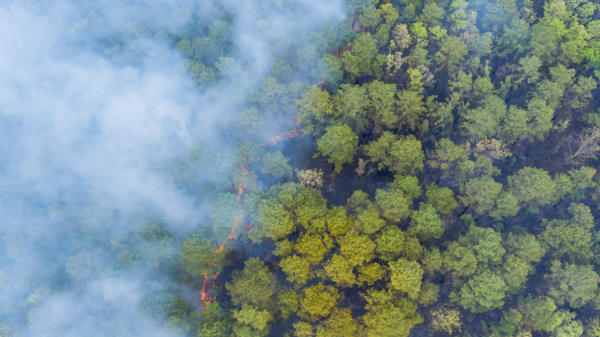Smoke is a common phenomenon in fires. It is produced when combustible materials are burnt. This toxic mixture emits particles such as soot, ash, heavy metals and hydrocarbons. Smoke can sometimes be invisible to the naked eye. Depending on the material burned and the temperature, it can also change color: from white to gray to black. Smoke can have serious consequences for the human body.

Published on 1 September 2023
A better understanding of smoke
In this article:
How is smoke composed?
The exact composition of smoke in a fire varies according to the source of the fire and the materials burned. Here are the main constituents of smoke:
- Nitrogen (N2): approx. 40-60%.
- Carbon dioxide (CO2): approx. 20-30%.
- Hydrocarbon gases (CH4, C2H2, C2H4, C2H6): approx. 10-15%.
- Carbon monoxide (CO): approx. 5-10%.
- Water vapour (H2O): approx. 5-10%.
- Oxygen (O2): approx. 3-5%.
- Ash, solid particles and soot: approx. 1-5%.
These figures vary depending on the situation and the type of fire.
Where does the smoke come from?
In France, 1 domestic fire breaks out every 2 minutes. In 1 out of 4 cases, the fire was triggered by a poorly maintained electrical appliance or installation. On average, there are 10,000 fire victims a year, including 800 fatalities. In 75% of cases, death results from asphyxiation due to the smoke released by the flames.
The smoke produced during a house fire can come from a variety of sources. These include fires :
- Electrical and electronic: caused by short circuits, overloaded sockets, faulty appliances
- Kitchen: caused by cooking errors, grease or oil fires
- Fuels: such as wood fires, paper and cardboard, plastics, etc.
When using flammable materials, it is advisable to observe the relevant safety instructions and regulations. So if these materials are burned, they can cause serious health damage.
How does smoke affect the body?
What are the effects?
The smoke produced by a fire can cause serious consequences because of the particles it contains. Fine particles can penetrate deep into the respiratory tract and lungs. Once inhaled, smoke causes :
- An increase in heart rate
- Irritation of the respiratory system
- Increased risk of asthma, bronchiolitis, bronchitis and cancer.
Smoke also contains toxic substances such as carbon monoxide (CO) and sulfur dioxide (SO2), which affect the eyes, skin and nervous system. Carbon monoxide (CO), an odorless, colorless and invisible gas, is particularly dangerous. If inhaled in large doses, it can cause symptoms such as dizziness, nausea, headaches and even death.
What should I do if I see smoke?
To protect your health and safety from smoke inhalation, here’s what to do in the event of a fire:
1- Evacuate the area as quickly as possible, covering your nose and mouth with a handkerchief or piece of clothing.
2- Call emergency services on 18 or 112
3- Stay away from the source of smoke until help arrives. If you are near the exit or on a lower floor than the fire, get out.
Otherwise, if you are on a higher floor or even on the same landing, stay put by adopting the right gestures:
- Close doors;
- Water and seal with wet cloths if smoke passes underneath.
- Wait for help at a window
- Crawl on the floor, covering your nose and mouth with a damp handkerchief, if smoke enters the room.
How to avoid the risk of fire?
It’s important to perform certain tasks to avoid smoke inhalation and prevent fires in the home:
- Regular maintenance of electrical installations and appliances
- Carry out minor repairs such as changing a faulty socket or replacing a bare wire
- Avoid overloading power strips to avoid the risk of overheating.
- Sweep the chimney once a year
- Store flammable products and other combustible materials in safe, outdoor locations.
- Check fire extinguishers
- Have a smoke alarm installed.
What does the law say about smoke detectors?
Smoke detection is crucial to the safety of people in buildings. Smoke alarms are devices designed to detect the presence of smoke in the air. They play a key role in triggering an audible alarm if smoke is suspected. This detector alerts occupants to evacuate the premises.
In France, since March 8, 2015, it has been mandatory to install a smoke detector (DAAF) in all homes. This device must be EN 14604 certified and bear the CE mark. This standard guarantees that the product has passed sufficient performance tests and complies with safety requirements.
The smoke detector is best installed on the ceiling. In apartment buildings, we recommend installing one DAAF per floor. For homes with a large surface area, it’s best to install several products for optimum security. To ensure proper operation, we recommend testing and dusting the product at least once a year.
Smoke is a toxic, asphyxiating gas. That’s why it’s so important to be able to detect it early to avoid suffering its consequences. Smoke detection is not something to be taken lightly.
Smoke detectors are designed for early detection of fire. They ensure the safety of a home and its occupants.